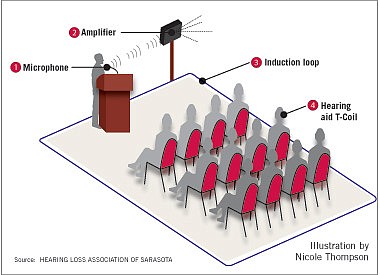- May 1, 2024
-
-
Loading

Loading

Sarasota resident Dick Gallette has long-enjoyed attending movies at Burns Court Cinema with his wife, but he normally had to study the synopsis of the movie before attending, because he knew he would miss hearing a lot of the dialogue.
For approximately 110,000 people in Sarasota and Manatee counties living with hearing loss, daily activities they once enjoyed can become stressful, and many of them significantly cut back on social interactions. Luckily, with the growing popularity of hearing loop technology, more local establishments are offering these residents a new opportunity to enjoy their favorite sound-related activities.
Last month, Burns Court Cinema became the latest Sarasota establishment to adopt the hearing loop technology, and it’s the first movie theater in the state to do so.
Gallette and his wife returned to see a film in one of the cinema’s two hearing-loop-equipped theaters, and he said, this time, the experience was much more enjoyable.
“It made all the difference in the world with clarity,” said Gallette. “You can never improve your hearing to the way it used to be, but this is the single biggest improvement they’ve made for the hearing impaired in many years. I look forward to going more places with a hearing loop.”
Getting wired
According to Edward Ogiba, executive director of the Hearing Loss Association of Sarasota, this technology is relatively simple and inexpensive, and he hopes to see more local venues take advantage of it.
“It’s already been used in Europe for the last 50 years,” said Ogiba. “We’re just starting to catch up in the United States.”
A typical hearing loop system consists of an amplified sound, which is then directed to a wire, or induction loop, that circles a desired room and broadcasts a magnetic, wireless signal to hearing aids or cochlear implants equipped with a telecoil.
The biggest complaint associated with older, headphone technology and hearing aids is that although the device would amplify the desired sound, it would also amplify the ambient noise in the room. So, the problem wasn’t volume; it was clarity.
Because the hearing loop system broadcasts the audio signal directly into the hearing aid, users receive an isolated signal with clarity. For the increased quality of life the device offers, it’s relatively affordable.
Depending on the venue and complexity of installation, costs start as low as $2,000, and the system requires virtually no maintenance.
“This system is the ultimate for people with these devices,” said Ogiba. “All you need is a device with a T-coil, and almost all of them come with one.”
Growing demand
Sarasota’s unique demographics have made it a hot spot for hearing loop technology. According to Ogiba, Sarasota’s population has the highest incidence of hearing loss in the country, with approximately 16%, and during the past year, the number of venues offering the service has grown significantly. Today, Sarasota is home to 44 looped establishments, many of which are in the arts community.
The Van Wezel Performing Arts Hall was the first performing-arts center to incorporate the loop, and Executive Director Mary Bensel said it’s been a rewarding experience.
“Where better to use this technology than here, with our aging population and arts community?” said Bensel. “It’s one happiest things I’ve ever done. We’ve had calls from people who were literally crying because they were so happy they could come back.”
Sarasota County is one of the first in the country to have the majority of its performing-arts theaters looped, and other locations are following suit. Churches, senior residences and community centers are taking advantage of the technology, and even some local businesses and restaurants, such as Whole Foods Market and Owen’s Fish Camp, are onboard.
Ogiba says he hopes to see hearing loops continue to show up in various local establishments.
“In Europe, a lot of the first venues to get it were arts-related,” said Ogiba. “But, over time, they started using them in worship centers and retailers. We’re trying to duplicate that here.”
HOW HEARING LOOP WORKS
The Hearing Loop System works by hooking up an existing microphone and amplifier to an induction loop, which is placed around the perimeter of the theater, meeting room or area where an audience or congregation sits. The magnetic field created by the loop projects the sound directly to a T-Coil, a wireless receiver that acts as a loudspeaker inside a hearing aid. Most hearing aids are equipped with a T-Coil.
View Venues in Sarasota and Manatee Counties with Hearing Loop in a larger map